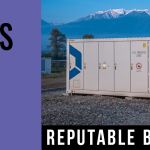 The China Energy Storage Market is set to grow from its current market value of more than $700 million to over $6 billion by 2024; as reported in the latest study by Global Market Insights, Inc.
The China Energy Storage Market is set to grow from its current market value of more than $700 million to over $6 billion by 2024; as reported in the latest study by Global Market Insights, Inc.
China energy storage market size is set to witness robust growth on account of rapidly growing ancillary service industry coupled with ongoing investments toward smart-grid infrastructure development. Furthermore, rising deployment of energy storage devices aimed toward enhancing the grid stability as a countermeasure to the effects of extensive penetration of intermittent power from renewables will augment the industry size.
Declining technology costs in conjunction with development of new technologies and advancement of existing systems will positively influence China energy storage market size. Lithium ion batteries has witnessed a drop of over 50% in per unit cost in last few years and will continue to follow the trend. Reformative business scenario along with improving economies of scale across battery manufacturing industry will further stimulate the industry size.
Shifting focus toward limiting carbon emission to curb the consequence of global warming coupled with rising implementation of supportive legislative endeavors will boost China energy storage market growth. Nonetheless, ongoing reduction in government subsidy on renewables may impact the industry, but the subsidy benefits losses may be compensated by reducing technology prices.
China flow vanadium energy storage market is projected to exceed USD 3 billion by 2024. Ability to offer virtually unlimited storage capacity, long scale duration, rapid response time, and negligible self-discharge are some of the key features which make the technology suitable for large scale renewable integration applications over its available alternatives. Furthermore, vast reserves of vanadium in the country may imply lower prices, minimal currency risks and ease of availability for the manufacturers, which will propel the industry growth.
read more
 Eversource Energy is working out a lease agreement with Provincetown, Mass. to site a 25-megawatt energy storage facility at the town’s transfer station. The energy will be used to “increase reliability and supplement the electric infrastructure for Cape Cod and Martha’s Vineyard,” according to the
Eversource Energy is working out a lease agreement with Provincetown, Mass. to site a 25-megawatt energy storage facility at the town’s transfer station. The energy will be used to “increase reliability and supplement the electric infrastructure for Cape Cod and Martha’s Vineyard,” according to the  A transformation in the energy sector has begun. The momentum toward low-carbon energy generation — driven by our need for secure, affordable and sustainable energy supply — will see the days of fossil fuel domination fade into obscurity. As natural gas and renewables continue to dominate new capacity additions, one of the components that has kept renewables from becoming the dominant technology to date has been intermittency. The intermittency of solar and wind has always been a challenge for grids, especially ones with high renewable penetration levels. At Sonnedix, where we build, acquire and operate solar power plants, we are aware of this challenge. But this is changing, and energy storage has a major role to play.
A transformation in the energy sector has begun. The momentum toward low-carbon energy generation — driven by our need for secure, affordable and sustainable energy supply — will see the days of fossil fuel domination fade into obscurity. As natural gas and renewables continue to dominate new capacity additions, one of the components that has kept renewables from becoming the dominant technology to date has been intermittency. The intermittency of solar and wind has always been a challenge for grids, especially ones with high renewable penetration levels. At Sonnedix, where we build, acquire and operate solar power plants, we are aware of this challenge. But this is changing, and energy storage has a major role to play. Japan’s Mitsubishi Electric has won a contract from global engineering company Chiyoda Corporation for its BLEnDer RE energy storage system.
Japan’s Mitsubishi Electric has won a contract from global engineering company Chiyoda Corporation for its BLEnDer RE energy storage system. The booming renewables industry in Texas should, in theory, create a role for energy storage plants to manage its variability.
The booming renewables industry in Texas should, in theory, create a role for energy storage plants to manage its variability. The workshop attended by partners and customers is the opportunity to show on site a live 1MW micro grid demonstration including a Battery Energy Storage container, genset and variable loads.
The workshop attended by partners and customers is the opportunity to show on site a live 1MW micro grid demonstration including a Battery Energy Storage container, genset and variable loads. Perhaps it’s my inborn bias towards news about technology companies (in my former journalism life, I covered the high-tech industry), but my mind keeps wandering this week back to the revelation in early November that software company VMware not only plans to build a microgrid at its Palo Alto, California, headquarters, it also is teaming up with its host city to design the installation.
Perhaps it’s my inborn bias towards news about technology companies (in my former journalism life, I covered the high-tech industry), but my mind keeps wandering this week back to the revelation in early November that software company VMware not only plans to build a microgrid at its Palo Alto, California, headquarters, it also is teaming up with its host city to design the installation. November 19 (Renewables Now) – Gresham House Energy Storage Fund plc (LON:GRID), launched recently by UK asset management firm Gresham House Plc (LON:GHE), announced on Friday that it has wrapped up the acquisition of its 70-MW seed portfolio.
November 19 (Renewables Now) – Gresham House Energy Storage Fund plc (LON:GRID), launched recently by UK asset management firm Gresham House Plc (LON:GHE), announced on Friday that it has wrapped up the acquisition of its 70-MW seed portfolio. Stem Inc
Stem Inc Stem Inc, which offers commercial and industrial (C&I) customers battery storage systems to lower their energy costs, has partnered with Canadian state-owned utility Ontario Power Generation to offer Ontario businesses ‘no-money-down’ energy storage solutions.
Stem Inc, which offers commercial and industrial (C&I) customers battery storage systems to lower their energy costs, has partnered with Canadian state-owned utility Ontario Power Generation to offer Ontario businesses ‘no-money-down’ energy storage solutions.



